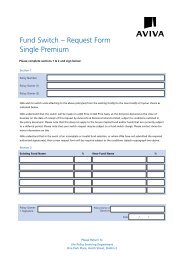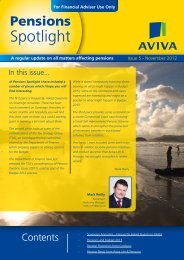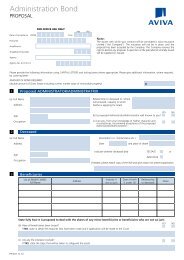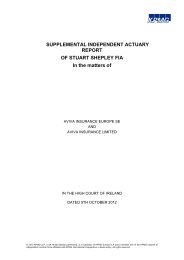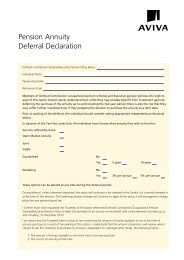Mind the Gap report Ireland 2mb (PDF) - Aviva
Mind the Gap report Ireland 2mb (PDF) - Aviva
Mind the Gap report Ireland 2mb (PDF) - Aviva
You also want an ePaper? Increase the reach of your titles
YUMPU automatically turns print PDFs into web optimized ePapers that Google loves.
<strong>Mind</strong> The <strong>Gap</strong><br />
Quantifying The Pensions Savings <strong>Gap</strong> in <strong>Ireland</strong><br />
September 2010<br />
EPSG_CBC_IRELA_28473_BRO.indd 1 31/08/2010 17:21
About <strong>Aviva</strong><br />
<strong>Aviva</strong> is <strong>the</strong> world’s sixth-largest* insurance group. Our main<br />
business activities are long-term savings, fund management<br />
and general insurance, with worldwide total sales of £45.1<br />
billion and funds under management of £379 billion at<br />
31 December 2009.<br />
We have 53 million customers across Europe, North America<br />
and Asia Pacific. <strong>Aviva</strong> is <strong>the</strong> leading provider of life and<br />
pension products in Europe.<br />
In <strong>Ireland</strong>, <strong>Aviva</strong> is <strong>the</strong> largest multi-line insurance provider,<br />
serving over 1.2 million customers across our pensions,<br />
savings, investments, home, motor, commercial and health<br />
insurance portfolio.<br />
*based on gross worldwide premiums at 31 December 2009<br />
2 <strong>Mind</strong> The <strong>Gap</strong><br />
EPSG_CBC_IRELA_28473_BRO.indd 2 31/08/2010 17:21
Foreword from Jim Dowdall,<br />
Group Chief Executive, <strong>Aviva</strong><br />
<strong>Ireland</strong><br />
By 2051, just over 40 years from now, 50% of our current population reaches retirement age and <strong>the</strong><br />
number of people working in <strong>Ireland</strong> to fund those who are in retirement will drop from 6:1 to just<br />
2:1. Fur<strong>the</strong>r, although 54% of <strong>the</strong> population has some form of pension coverage in place, this figure<br />
has remained more or less static over <strong>the</strong> last few years. For those individuals with pension cover in<br />
place, <strong>the</strong> amount <strong>the</strong>y are currently setting aside will not be enough to meet <strong>the</strong>ir expected income<br />
requirements in retirement. Collectively, <strong>Ireland</strong> faces a €20.2bn annual gap in savings for retirement.<br />
<strong>Aviva</strong>’s inaugural study of <strong>the</strong> scale of Europe’s pensions funding issue is published at a time of<br />
recession in <strong>Ireland</strong>, falling consumer confidence, property market collapses, rising unemployment<br />
and increased cost of borrowing. The need for prudent and long-term financial planning has never<br />
been more to <strong>the</strong> fore.<br />
For many, planning for retirement is viewed as a problem for ano<strong>the</strong>r day but our research shows clearly that taking action today<br />
will significantly reduce <strong>the</strong> scale of <strong>the</strong> gap we face. With an aging population living longer and enjoying more active lifestyles<br />
than ever before, planning now for retirement is <strong>the</strong> only way to ensure that <strong>the</strong> appropriate funding will be <strong>the</strong>re in those<br />
‘golden years’.<br />
This issue has already been considered and debated by many in <strong>Ireland</strong>, most recently in <strong>the</strong> National Pensions Framework<br />
published in March 2010. Insurers too have a significant role to play and it is our intention that <strong>Aviva</strong>’s latest research, unique in<br />
Europe, will provide fur<strong>the</strong>r insights to inform this debate for Government, <strong>the</strong> pensions industry, employers and individuals at<br />
both national and European levels. The time for us all to work toge<strong>the</strong>r for a solution is now.<br />
Jim Dowdall<br />
Chief Executive Officer<br />
<strong>Aviva</strong> <strong>Ireland</strong><br />
aviva.co.uk 3 3<br />
EPSG_CBC_IRELA_28473_BRO.indd 3 31/08/2010 17:21
Key Findings for<br />
<strong>Ireland</strong><br />
Those retiring in <strong>Ireland</strong> between 2011 and 2051 need to collectively save an<br />
additional €20.2bn per annum to meet <strong>the</strong>ir expected income in retirement.<br />
While averages typically mask <strong>the</strong> impact on <strong>the</strong> most vulnerable, this €20.2bn<br />
annual pensions savings gap equates to an average of €9,100 per retiree or<br />
€758 per month for individuals retiring between 2011 and 2051. The pensions<br />
savings gap is defined as <strong>the</strong> additional amount that individuals would need to<br />
save to ensure an adequate lifestyle in retirement. 1<br />
In comparison with o<strong>the</strong>r European countries <strong>the</strong> severity of <strong>Ireland</strong>’s pensions<br />
savings gap in monetary terms per individual ranks in <strong>the</strong> top 3, behind <strong>the</strong> UK<br />
and Germany.<br />
Table 1. Savings and retirement income gap for individuals retiring 2011-51<br />
Country<br />
Annual pensions<br />
savings gap per<br />
person (2000s)<br />
Annual pensions<br />
savings gap by<br />
country (2 bn)<br />
United Kingdom 12.3 379.0<br />
Germany 11.6 468.8<br />
Republic of <strong>Ireland</strong> 9.1 20.2<br />
Spain 7.0 170.5<br />
France 6.1 189.1<br />
Turkey 5.7 221.4<br />
Czech Republic 5.5 30.3<br />
Italy 3.1 97.6<br />
Russia 2.9 202.1<br />
Poland 1.9 38.1<br />
Romania [0.8] [8.4]<br />
Hungary 0.5(2) 2.5<br />
1 ”Adequate” is defined by <strong>the</strong> OECD as an average retirement income of 70% of pre-retirement income and is in<br />
line with <strong>Aviva</strong>’s own Consumer Attitudes to Saving Research. <strong>Aviva</strong> has fur<strong>the</strong>r refined this definition for different<br />
income groups as 90% for low income groups, 65% for middle income groups and 55% for high income groups.<br />
4 <strong>Mind</strong> The <strong>Gap</strong><br />
Case study: Karen Murphy<br />
“At 33, I felt retirement was<br />
something in <strong>the</strong> far off<br />
future, something I didn’t<br />
have to worry about yet, as<br />
<strong>the</strong>re are many more working<br />
years ahead of me.<br />
However in <strong>the</strong> last year, I<br />
have married and I have just<br />
given birth to my daughter<br />
Sophie. It is fair to say life<br />
has changed, as have my<br />
responsibilities and priorities.<br />
I work as a teacher<br />
part-time and have a pension<br />
at work, but now that I have<br />
additional responsibilities I feel<br />
I need to do more so I can<br />
retire comfortably and not be<br />
dependent on my children.<br />
I believe it is never too early to<br />
start planning for retirement<br />
and I put a little extra aside<br />
each month into an AVC<br />
with <strong>Aviva</strong>. This is important<br />
to me as I want to be able to<br />
continue to enjoy <strong>the</strong> good<br />
lifestyle that I currently have<br />
well into retirement.”<br />
EPSG_CBC_IRELA_28473_BRO.indd 4 31/08/2010 17:21
As Table 2 shows, <strong>the</strong> gap is most easily resolved for those who are younger<br />
as <strong>the</strong>ir gap is lower, reinforcing <strong>the</strong> benefits of starting pension provision at<br />
a younger age. Conversely, individuals who are not currently setting money<br />
aside for <strong>the</strong>ir pension or are at an older age face a greater gap. In 2010 for<br />
instance, individuals who are nearing <strong>the</strong> retirement age of 65 are facing a<br />
significant shortfall, one that may not be feasible for <strong>the</strong>m to address.<br />
Table 2. Average per person annual pensions gap in <strong>Ireland</strong> by age in 2010<br />
Age in 2010<br />
All those<br />
retiring 2011-51<br />
up to age 65<br />
60 years 50 years 40 years 30 years 20 years<br />
€ 9,100 €21,100 €6,900 €3,900 €2,500 €1,700<br />
To really understand what <strong>the</strong> gap means for individuals in <strong>Ireland</strong>, we need<br />
to go fur<strong>the</strong>r, measuring <strong>the</strong> gap using disposable income. This provides a<br />
sense of <strong>the</strong> affordability for individuals of closing <strong>the</strong> gap. The average gap<br />
for <strong>Ireland</strong>’s retirees is <strong>the</strong> equivalent of 34% of disposable income, although<br />
again, this varies significantly depending on age in 2010.<br />
Table 3. Pensions gap in <strong>Ireland</strong> as a percentage of disposable income by<br />
age in 2010<br />
Age in 2010<br />
Average 60 years 50 years 40 years 30 years 20 years<br />
34% 78% 26% 14% 9% 6%<br />
“It’s crucial that we each<br />
mind our own ‘personal<br />
gap’. <strong>Aviva</strong>’s research<br />
provides valuable insight<br />
into <strong>the</strong> extent of <strong>the</strong><br />
gap on a national<br />
and per-capita basis<br />
in <strong>Ireland</strong> and across<br />
Europe. Yet factors such<br />
as age, amount being<br />
saved and expectations<br />
can’t be ignored. Will<br />
we continue with<br />
our current level of<br />
saving, increase or even<br />
decrease it? All <strong>the</strong>se<br />
impact on <strong>the</strong> gap for<br />
each individual.”<br />
EPSG_CBC_IRELA_28473_BRO.indd 5 31/08/2010 17:21<br />
5
What About O<strong>the</strong>r Assets<br />
and Non-Pensions Savings?<br />
Many of us consider o<strong>the</strong>r assets as part of our plan for a<br />
secure retirement. But to what extent can <strong>the</strong>se non-pensions<br />
assets, such as <strong>the</strong> family home, be converted to retirement<br />
incomes that will help address <strong>the</strong> shortfall in income?<br />
On an annual basis, <strong>Aviva</strong> estimates that Europeans will have<br />
somewhere between €370bn (17% of <strong>the</strong> pensions gap) and<br />
€1,080bn (60% of <strong>the</strong> pensions gap) in non-pensions assets to<br />
potentially draw on in <strong>the</strong>ir retirement.<br />
Attitudes in <strong>Ireland</strong><br />
Towards Saving<br />
When considering <strong>Ireland</strong>’s pensions savings gap and how it<br />
can be bridged, it helps to look at what our current attitude<br />
towards saving for retirement is and in compiling this <strong>report</strong><br />
<strong>Aviva</strong> has also drawn on its multi-year research on consumer<br />
attitudes to savings.<br />
What do we expect our income to be<br />
when we retire?<br />
<strong>Aviva</strong> research among those who are yet to reach retirement<br />
age shows that almost 58% of people in <strong>Ireland</strong> think <strong>the</strong>y<br />
will need at least half of <strong>the</strong>ir monthly income to ‘get by’ in<br />
retirement. Yet 57% also said <strong>the</strong>y would prefer to have at<br />
least three-quarters of <strong>the</strong>ir income. Clearly <strong>the</strong> income group<br />
in which <strong>the</strong> individual sits has a bearing on <strong>the</strong> severity or<br />
o<strong>the</strong>rwise of <strong>the</strong> monetary gap.*<br />
Where do we expect our main retirement<br />
income to come from?<br />
30% of those who are working believe that <strong>the</strong> most<br />
important source of income to <strong>the</strong>m when <strong>the</strong>y will retire will<br />
be a private pension plan and 22% expect <strong>the</strong> state pension<br />
to be <strong>the</strong>ir most important source of income when <strong>the</strong>y retire.<br />
Interestingly 15% believe that <strong>the</strong> practice of regularly setting<br />
aside money in non-pension savings and investments will give<br />
6 <strong>Mind</strong> The <strong>Gap</strong><br />
In <strong>Ireland</strong>, non-pension assets could, if calculated with bequests<br />
to family, close as little as 30% of <strong>the</strong> gap. It is clear that nonpension<br />
assets will not, on <strong>the</strong>ir own, fill <strong>the</strong> pensions gap,<br />
even assuming people were able or willing to spend down <strong>the</strong><br />
totality of <strong>the</strong>ir non-pension assets in retirement. Therefore a<br />
combination of actions will be required to resolve <strong>the</strong> situation.<br />
<strong>the</strong>m <strong>the</strong>ir most important source of income when <strong>the</strong>y retire.<br />
However <strong>the</strong> liquidity of <strong>the</strong>se non-pensions savings and <strong>the</strong><br />
distribution of risk in those investments needs to be considered.<br />
For example, those consumers with an overweight portion of<br />
<strong>the</strong>ir assets in property are clearly exposed to both liquidity risk<br />
and valuation risk at present.<br />
<strong>Ireland</strong><br />
14<br />
All figures in charts expressed as percentages<br />
9<br />
7<br />
3<br />
30<br />
A state pension<br />
Regular saving for retirement<br />
Pension plan from a financial provider<br />
Working beyond retirement age<br />
*<strong>Aviva</strong> Consumer Attitudes to Savings Research, May 2010<br />
22<br />
15<br />
Your home<br />
Property o<strong>the</strong>r than your main home<br />
Money provided by your family<br />
Valuables which you plan to sell<br />
EPSG_CBC_IRELA_28473_BRO.indd 6 31/08/2010 17:21
Key Implications for Government,<br />
The Pensions Industry and<br />
Consumers:<br />
Although <strong>the</strong> €20.2bn gap for <strong>Ireland</strong> may seem daunting,<br />
<strong>the</strong> positive news is that initiatives to close <strong>the</strong> pensions<br />
savings gap and boost retirement savings are underway. The<br />
National Pensions Framework identified that <strong>the</strong> solutions<br />
to this problem lie in all of us working toge<strong>the</strong>r to increase<br />
savings, to re-educate younger generations and to change our<br />
current work practices to reflect <strong>the</strong> longer lives we are living.<br />
Government, <strong>the</strong> pensions industry, employers, social partners<br />
and consumers need to come toge<strong>the</strong>r and take collaborative<br />
ownership and responsibility for resolving <strong>the</strong> issue:<br />
Education of individuals on what is an appropriate<br />
amount to set aside in retirement is paramount.<br />
l Individuals need to clearly understand <strong>the</strong>ir own current<br />
and future financial position before <strong>the</strong>y will take<br />
responsibility. Fur<strong>the</strong>r action, such as providing every<br />
citizen of <strong>the</strong> EU with an annual consolidated statement<br />
of <strong>the</strong>ir projected pension from all sources would help<br />
bring retirement planning to <strong>the</strong> fore. Visibility of<br />
<strong>the</strong>ir potential future income may do more to change<br />
consumer behaviours than compulsion measures such as<br />
auto-enrolment.<br />
Pension savings incentives should be<br />
reformed:<br />
l As this and much o<strong>the</strong>r research shows, it pays to start<br />
saving at a younger age. However <strong>the</strong> future is a distant<br />
vision and individuals must be incentivised to save for<br />
retirement. Worryingly, pension coverage for employees<br />
aged under 30 years of age remains low at 37% in Q1<br />
2008. Given <strong>the</strong> recession, it is likely that as disposable<br />
income for many has declined, this coverage has ei<strong>the</strong>r<br />
stayed static or indeed declined.<br />
l Reform and an increase in <strong>the</strong> incentives provided for<br />
pensions is paramount. Despite growing awareness of <strong>the</strong><br />
importance of having a pension, overall pension coverage<br />
has remained largely static since 2002, at 54% of <strong>the</strong><br />
population in Q1 2008.<br />
l A full review of <strong>the</strong> tax incentives – those currently<br />
available and potential alternatives - should be undertaken<br />
to ensure that incentives are equitable and will not only<br />
change behaviour of those who are most at risk of an<br />
income drop but also provide Government with value for<br />
money. This research highlights that middle income groups<br />
are most exposed to <strong>the</strong> pensions gap, so reducing <strong>the</strong><br />
tax incentives for this group, for example by reducing <strong>the</strong><br />
marginal rate of relief available to this group, may have a<br />
disproportionate impact and create larger societal issues in<br />
future years.<br />
Government must continue to lead and<br />
deliver change:<br />
l At a time when many issues are pressing, <strong>the</strong> pensions<br />
gap can appear a problem far away that does not require<br />
addressing right now. In publishing <strong>the</strong> National Pensions<br />
Framework in March 2010, Government has led <strong>the</strong> way<br />
in putting pensions on <strong>the</strong> national agenda. This must<br />
continue to involve all stakeholders.<br />
l Consideration needs to be given to establishing a<br />
‘Pensions Czar’ to continue this leadership of <strong>the</strong> issue,<br />
to drive <strong>the</strong> partnership approach to pension provision<br />
between Government, <strong>the</strong> pensions industry, employers<br />
and individuals as referred to in <strong>the</strong> National Pensions<br />
Framework.<br />
Conclusion<br />
The good fortune of living longer and more active lifestyles<br />
should not become a burden to individuals or society. With<br />
an informed and reformed approach to retirement planning,<br />
all of us should be able to enjoy our retirement based on<br />
<strong>the</strong> contributions made during our working lives to our<br />
community, our economy and our families. This involves<br />
equal responsibility from Government, employers, <strong>the</strong><br />
pensions industry and individuals. By making <strong>the</strong>se findings<br />
available and aiding greater understanding of <strong>the</strong> gap faced<br />
in <strong>Ireland</strong>, <strong>Aviva</strong> intends to lead and participate in debate at<br />
both national and EU level, to identify real solutions to this<br />
problem.<br />
EPSG_CBC_IRELA_28473_BRO.indd 7 31/08/2010 17:21<br />
7
For fur<strong>the</strong>r information please contact -<br />
Media relations enquiries:<br />
Sarah Poulter<br />
01904 452828<br />
07800 691569<br />
sarah.poulter@aviva.co.uk<br />
Public affairs enquiries:<br />
Katy Litt<br />
01904 452828<br />
07800 695815<br />
katy.litt@aviva.com<br />
EPSG_CBC_IRELA_28473 08/2010 © <strong>Aviva</strong> plc<br />
EPSG_CBC_IRELA_28473_BRO.indd 8 31/08/2010 17:21






